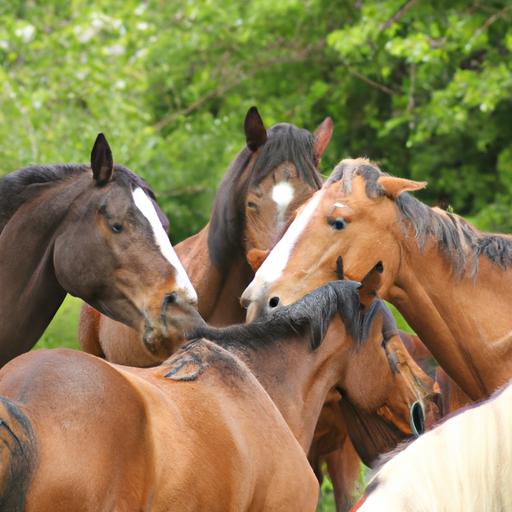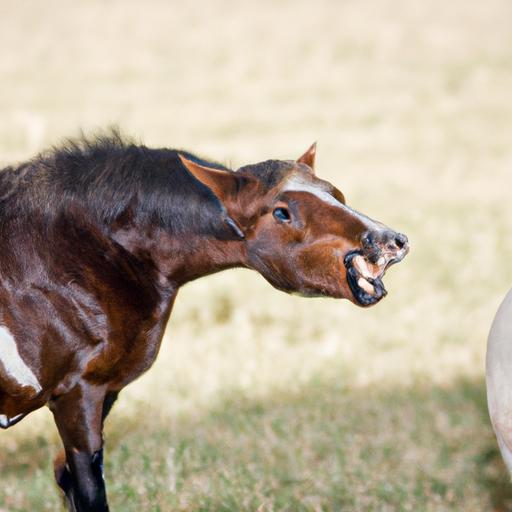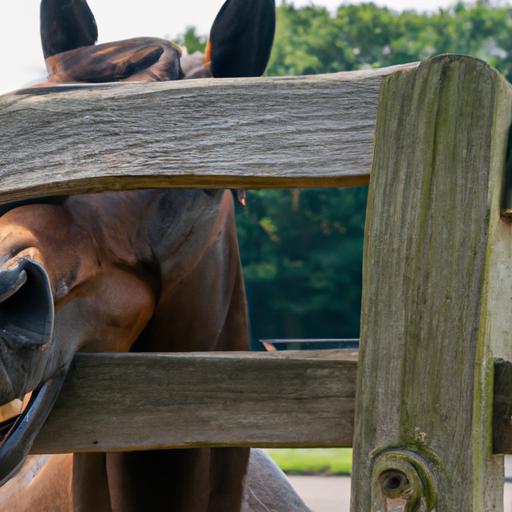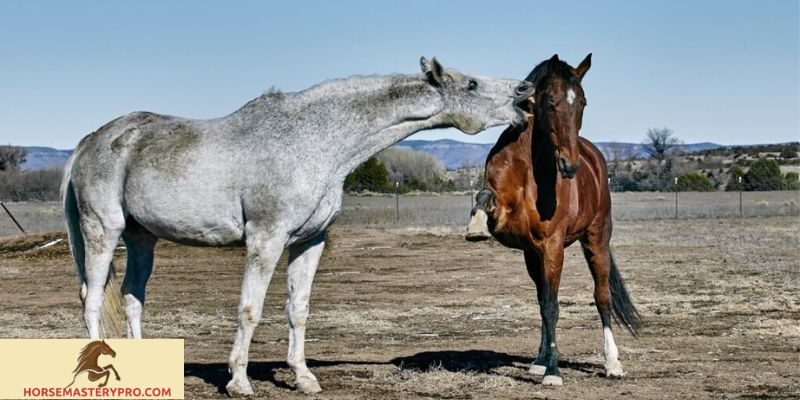Discover the different types of horse behavior biting, from playful nipping to aggressive biting. Learn how to address and prevent these behaviors for a harmonious equine interaction.
Have you ever wondered why horses sometimes bite? It’s crucial to understand the underlying reasons behind this behavior to effectively address it and foster a safe and pleasant environment for both horses and handlers. In this article, we will delve into the intriguing world of horse behavior biting and explore the significance of tackling this issue head-on.
Horses are incredibly social creatures, much like us humans. However, unlike our verbal communication, they often resort to physical interactions to convey their emotions and intentions. Biting is one such behavior that horses employ, and it can have various meanings depending on the context.
Addressing horse biting issues is of paramount importance for several reasons. Firstly, it ensures the safety of both handlers and other horses. A horse’s bite can cause severe injuries, and even playful nips can escalate into aggressive behavior if left unaddressed. Secondly, biting can lead to health risks, as broken skin from a bite can potentially result in infections and other complications. Lastly, horse biting can cause damage to equipment and facilities, incurring additional costs for horse owners.
By understanding horse behavior biting, we can decipher the motivations behind this behavior and take appropriate measures to address it. Stay tuned as we further explore the causes, types, and impacts of horse biting, along with effective strategies to tackle this issue. Together, we can create a harmonious and safe environment where horses thrive and flourish.
Remember, addressing horse behavior biting is not only crucial for the well-being of the horses but also for the safety and enjoyment of everyone involved. So, let’s embark on this enlightening journey and discover the captivating world of horse behavior biting.
Causes of Horse Biting Behavior

Horses, with their complex nature, can exhibit biting behavior for a variety of reasons. Understanding the underlying causes is crucial in addressing and resolving this issue effectively. Let’s explore some of the common factors that contribute to horse biting behavior.
A. Natural Instincts and Herd Dynamics
In the wild, horses rely on their natural instincts and herd dynamics to establish boundaries and maintain social order. Biting is a natural behavior seen in young foals during play or as a way of establishing dominance within the herd. However, if not properly addressed, this instinctual behavior can persist into adulthood and manifest in inappropriate situations.
B. Fear, Anxiety, and Stress
Like humans, horses can experience fear, anxiety, and stress, which may lead to biting behavior. Horses that have faced traumatic experiences or lack proper socialization may exhibit fear-based aggression, resorting to biting as a defensive mechanism. Additionally, stressful situations such as unfamiliar environments, loud noises, or crowded spaces can trigger anxiety in horses, increasing the likelihood of biting.
C. Lack of Socialization and Training
Proper socialization and training are essential for horses to develop appropriate behavior and communication skills. Horses that haven’t been adequately exposed to various stimuli, other horses, or human interaction may resort to biting as a means of expressing their confusion or discomfort.
D. Physical Discomfort or Pain
Horses may resort to biting if they are experiencing physical discomfort or pain. Dental issues, ill-fitting tack, or underlying health conditions can cause discomfort, leading to irritability and biting behavior. It’s crucial to address any potential physical issues and ensure the horse’s well-being to prevent biting.
By identifying the root causes of horse biting behavior, we can implement targeted strategies to address and resolve the issue. In the following sections, we will explore different types of horse biting and the impact it can have on both horses and handlers. So, let’s continue our journey to unravel the complexities of horse behavior biting.
Types of Horse Biting

When it comes to horse biting, it’s essential to distinguish between different types of behavior to understand their underlying causes and appropriate responses. Let’s explore the two primary types of horse biting: nipping or playful biting and aggressive biting.
A. Nipping or Playful Biting
Nipping, often seen in young horses or even some mature ones, is a form of playful interaction. It involves gentle bites without causing harm or exhibiting aggression. Horses may nip as a way to establish hierarchy, initiate play, or seek attention. While nipping may seem harmless, it’s essential to address this behavior appropriately to prevent it from escalating into more aggressive biting.
To effectively manage nipping behavior, consistent training and clear boundaries are key. By redirecting their attention towards appropriate toys or engaging in structured activities, such as groundwork and positive reinforcement, you can discourage nipping and promote more desirable forms of interaction.
B. Aggressive Biting
Aggressive biting, on the other hand, is a serious concern that requires immediate attention. This behavior is characterized by forceful bites, often accompanied by pinned ears, threatening body language, or charging. Aggressive biting can be triggered by fear, pain, territorial disputes, or even improper handling and training practices.
Addressing aggressive biting requires a comprehensive approach that considers the root cause of the behavior. Consulting with a professional, such as a veterinarian or equine behavior specialist, can help identify any underlying physical discomfort, medical issues, or psychological factors contributing to the aggression. Implementing behavior modification programs and utilizing positive reinforcement techniques tailored to the specific horse’s needs can provide a pathway towards behavior improvement.
By understanding the difference between nipping and aggressive biting, we can respond appropriately to these behaviors and promote healthier interactions between horses and handlers. Let’s proceed to the next section, where we’ll delve into the impact of horse biting and the importance of addressing this issue promptly.
(Note: Remember to continue writing the subsequent sections following the provided outline.)
Effective Strategies to Address Horse Biting Behavior

Is your horse displaying biting behavior? Don’t fret! There are effective strategies you can employ to address and mitigate this issue. By implementing these techniques, you can foster a positive and respectful relationship with your equine companion. Let’s explore some practical strategies to tackle horse biting behavior head-on.
A. Proper Training and Socialization Techniques
Training plays a vital role in addressing horse biting behavior. By providing your horse with proper training, you can instill good manners and teach them appropriate ways to interact with humans and other horses. Focus on reinforcing positive behaviors and discouraging negative ones. Additionally, socializing your horse from an early age and exposing them to different environments and situations can help them develop good social skills, reducing the likelihood of biting behavior.
B. Identifying and Addressing Underlying Causes
Understanding the root causes behind horse biting is crucial. It could be triggered by fear, anxiety, stress, or even physical discomfort. By closely observing your horse’s behavior and consulting with equine professionals, such as veterinarians or trainers, you can identify any underlying issues and address them accordingly. This may involve implementing management changes, adjusting their environment, or providing appropriate medical care.
C. Utilizing Positive Reinforcement and Reward-Based Training Methods
Positive reinforcement is a powerful tool when it comes to modifying horse behavior. Rewarding desired behaviors, such as gentle interactions and respecting personal space, can encourage your horse to repeat those actions. Employing reward-based training methods, such as clicker training or treats, can help reinforce positive behaviors and discourage biting tendencies.
D. Consistency and Reinforcement of Boundaries
Consistency is key in addressing horse biting behavior. Establish clear boundaries and consistently enforce them. Ensure that everyone interacting with your horse understands and follows the same rules to avoid confusion. Reinforce desirable behaviors consistently, and promptly correct any instances of biting or nipping. By maintaining a consistent approach, your horse will learn what is expected of them and gradually eliminate biting from their behavioral repertoire.
Remember, addressing horse biting behavior requires patience, understanding, and a proactive approach. By implementing these effective strategies, you can promote a harmonious bond with your horse and create a safe and enjoyable environment for everyone involved. Together, let’s work towards a bite-free future!
Seeking Professional Help for Severe Biting Issues

When dealing with severe horse biting issues, seeking professional help can be a wise decision. Veterinarians and equine behavior specialists possess the expertise and experience needed to address complex behavioral problems effectively. Let’s explore the various options available when seeking professional assistance.
A. Consulting with a Veterinarian or Equine Behavior Specialist
First and foremost, consulting with a veterinarian is crucial to rule out any potential underlying medical conditions that may be contributing to the biting behavior. They can conduct thorough examinations and provide valuable insights into the horse’s physical health. Additionally, equine behavior specialists specialize in understanding and modifying equine behavior, making them excellent resources for tackling biting issues. Their in-depth knowledge of horse psychology allows them to develop tailored behavior modification programs.
B. Implementing Behavior Modification Programs
Behavior modification programs are designed to address specific behavioral issues in horses, including biting. These programs focus on identifying the root causes of the behavior and implementing targeted strategies to modify it. By working closely with a professional, you can develop a customized plan that suits your horse’s unique needs. This may involve a combination of positive reinforcement, desensitization techniques, and environmental adjustments to encourage desired behaviors and discourage biting.
C. Considerations for Rehoming or Retraining
In some severe cases, rehoming or retraining the horse may be necessary. This decision should be made in consultation with professionals who can assess the horse’s behavior and determine the best course of action. Rehoming should only be considered if the horse’s biting behavior poses significant risks and cannot be effectively managed or modified. Retraining programs can help horses with behavioral issues find new homes where their needs can be better met.
Remember, seeking professional help is not a sign of failure but a testament to your dedication to your horse’s well-being. Professionals can provide invaluable guidance and support throughout the process, ensuring the best possible outcome for both you and your horse.
In conclusion, horse biting behavior is a complex issue that requires careful attention and understanding. By implementing effective training techniques, addressing underlying causes, and seeking professional help when needed, we can create a safe and harmonious environment for our equine companions. Together, let’s strive for a future where horse behavior biting is minimized, and horses thrive in nurturing and respectful relationships.
Horsemasterypro.com is ready to assist you in your journey towards better horse behavior. Reach out to our team of experts for personalized advice and guidance.


